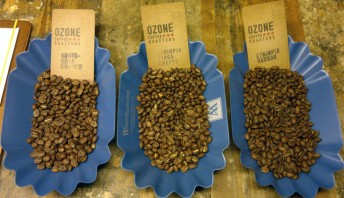 As I dragged my caffeine depleted limbs up through the door of Ozone on Shoreditch‘s Leonard Street, I hadn’t expected the evening to revolve around slurping coffee from a tablespoon, but this is what’s known as ‘cupping’ and this is why I was here.
As I dragged my caffeine depleted limbs up through the door of Ozone on Shoreditch‘s Leonard Street, I hadn’t expected the evening to revolve around slurping coffee from a tablespoon, but this is what’s known as ‘cupping’ and this is why I was here.
The preferred method of taste testing freshly ground, single-origin beans, cupping enables coffee professionals to determine the correct level of roast (from light to dark) and create their perfect blend.
Artisan coffee makers from New Zealand, Ozone have recently opened this roastery-cum-cafe, which is the first of its kind in London. They also supply wholesale to restaurants such as Bocca di Lupo, Moro and Morito and have won awards for their inspired blends.
The venue is described as ‘relaxed Antipodean style’ but upon entering I was struck by the sheer size and rather industrial vibe. Like a Victorian workhouse – all distressed wood, wrought iron and copper lamps – it’s situated on two floors with the street level acting as mezzanine, overlooking the bowels of the building. Spiral staircases and wire-iron railings divide the space, an espresso bar occupies the centre, surrounded by stools, breeze-block booths and window seats.
Downstairs, canvas sacks of coffee beans are strewn about and this is where you will find James, one half of the co-founding team, operating all manner of intimidating machinery. To my relief, the other half, Lizzie, assured me I would get my fix of coffee.
Ozone sources coffee from countries including Ethiopia and Guatemala and does so ethically through Trade Aid, which aims to maintain steady employment and fair wages for the farmers, with whom they are determined to build direct relationships. Back in London James is responsible for the handling of the raw, flavourless, green beans and the roasting process which miraculously breathes delicious, aromatic life into them.
He is clearly proud of his 1970’s Probat Roaster, which he assures us is a typical feat of reliable German mechanics. More modern, automatic roasters have been developed since, which store the specific settings needed to create the required roast but, as James explained, using fresh organic beans that are so variable in taste and texture requires a more hands-on approach.
Hands-on indeed and highly stringent! The bean temperature is logged every minute to ensure the roast is achieved to the exact degree and the machine filled to below capacity: up to 15kg rather than 23kg, as this allows for a more controlled, even roasting that achieves more ‘finesse’.
Reassuringly, and despite his evident expertise, James admitted to not fully understanding all the science behind coffee and, perhaps in a bid not to alienate us laymen, dismissed the roaster as a “big cement mixer on top of a barbecue burner”. The proof, he reminded us, is in the tasting. Or, returning to the science for the moment, the ‘cupping’.
This came next and involved three single-origin grinds two of which, the Harra and Yirgacheffe, were Ethiopian and the third a Guaya’b from Guatemala.
Each grind occupies a cup and hot, but not boiling, water is poured on top, the grains completely covered and left to infuse. We were encouraged to inhale the aromas before and after the addition of water and asked to describe what we could detect. Erm… chocolate?… spice?… I quietly chimed in, falling back on generic tasting notes I vaguely recalled from the sides of packets.
Help was on hand with tasting notes for each coffee and we were even shown a taste profile pie chart. Then, as soon as aromas of blueberries and tea-leaves were suggested, these flavours leapt from the cups.
Whether or not this was psychosomatic, I’m not sure, but it certainly got my brain to engage with my olfactory senses. In stark contrast, we also sampled a Robusta grind, the stronger high-caffeine bean that is used to give bog-standard coffee some weft. It was to Arabica beans’ subtle nuances what Lambrini is to Dom Perignon, and curiously smelt of burnt popcorn.
I had been under the misguided impression that all, or most, espresso roasts contained some Robusta beans. A braver companion outright queried this and both Lizzie and James looked flummoxed. Why would anyone in their right mind settle for this? The only reason they had this sample was due to a delivery for test roasts and this bean would not make it beyond the test lab!
Back to the cupping. The first step is to break the crust that forms after water has been added to the grains. Do this with a spoon and inhale while you do so to kick start the senses in preparation for tasting. The top layer of scum is then removed with the ‘all purpose’ spoon which is then used to lift a sample of the steeped coffee. This is tasted by slurping enthusiastically from the spoon, which unleashes the full flavour and aroma. At this point we all sounded like those soup-guzzling pariahs who annoy everyone at restaurants, except we were conforming to etiquette and so congratulated ourselves with a unison of ‘ahhs’.
The Ethiopian Harrar was the darkest roast with a deep fruity aroma. The blueberry one, in short. The others were more tea like; delicate, ‘citrussy’ and with a smoother ‘mouth feel’. All three of these, along with another bean, formed the blend that was Ozone’s lauded Hodson Brew. We were informed that four bean blends tend to be the limit. James also informed us that, after some experimentation, they now always ‘pre-blend’, i.e., combine the beans before roasting, which give the different flavours more time to infuse.
Cupping is the preferred taste test among experts as it perfectly facilitates the trial and error of arriving at a master blend. The set up is simple, quick and according to James, a fairer method as there are fewer variables than there would be with, say, espresso brewing.
Essentially, it is the purists’ approach and, when done professionally, the wearing of perfume, aftershaves and scented soaps is strictly prohibited. We were assured the rules had been relaxed for us but I still experienced a twinge of shame as I caught a lingering whiff of that morning’s deodorant.
Now with my coffee craving satisfied and my taste buds singing, the class concluded in the ‘coffee lab’ where the most hardcore science awaited. We were introduced to Sean, his V-60 coffee maker and array of apparatus that would’ve amused Heath Robinson no end. Sean had been brewing in here seemingly throughout the class and it was easy to imagine him doing this late into the night like some 21st century Dr Jekyll experiencing a prolonged ‘caffeine Hyde’.
The V-60, it was explained was created to simplify the coffee brewing process and bring it into people’s homes. Essentially a syphon, it is an odd looking contraption, and more resembles a chemistry kit than the familiar French Press or stove top espresso maker oft used today, but apparently almost every home kitchen in Japan will have one of these. In fact, they are so taken by this method, experts can spend 30 years honing their perfect brew which is then sought after by Japan’s rich and famous, who keep these V-60 magicians in their employ.
Despite this endless pursuit of perfection, there are a few set rules that define the ‘Chemex’ brewing method demonstrated by the V-60. Firstly, hot water removes any cleaning agent from the filter, then grains are added – a ratio of 60 grams per litre of water. The entire filtration process on wetting the grains should take 2 minutes and 30 seconds, and this is even timed with a stopwatch. The water is poured in stages, with 50 grams being used within the first 10 seconds to cover as much of the grains as possible. Known as the ‘blooming period’, this is followed by a semi-circular motion pour at the 30 second point and by 1 minute 30 seconds, 250 ml of water has been added.
Still with me? Well, apparently this exacting technique ensures reliable results, the original intention of chemist Peter J Schlumbohm who developed the method in 1941. What you get is a cleaner, purer brew with more delicate flavour and subtler ‘mouth feel’, which Sean humbly remarked, ‘makes it nice’.
The down-to-earth approach of our expert tutors helped digest the science and as such the class was utterly enthralling from beginning to end. Not only was there plenty of tasting during the 90 minutes, they made sure we didn’t depart without our own bag of freshly roasted beans and a few tips on home brewing.
First off, store the beans away from any food products and in a dark cupboard, not the fridge or freezer, which absorbs moisture and hampers the flavour. The ideal water temperature for brewing is 92C, and they use a thermometer to ensure this, but for those who don’t have the energy to unearth their chemistry set first thing in the morning, turn the kettle off just as it starts to steam.
For those using a French press, which, incidentally Sean doesn’t get on with, just give the water a single stir and remove the scum from the top about a minute before plunging. Approximately two tablespoons of coffee grains per cup is the correct measure and always use fresh beans (that will keep for up to ten days) grinding them just before brewing.
If all this sounds like too much effort, you could always just swing by Ozone to enjoy the perfect cup of Joe. Better still, pay a little extra and get your caffeine fix via a cupping session, which are held the first Wednesday of every month and cost just £25 per person. Happy slurping!
